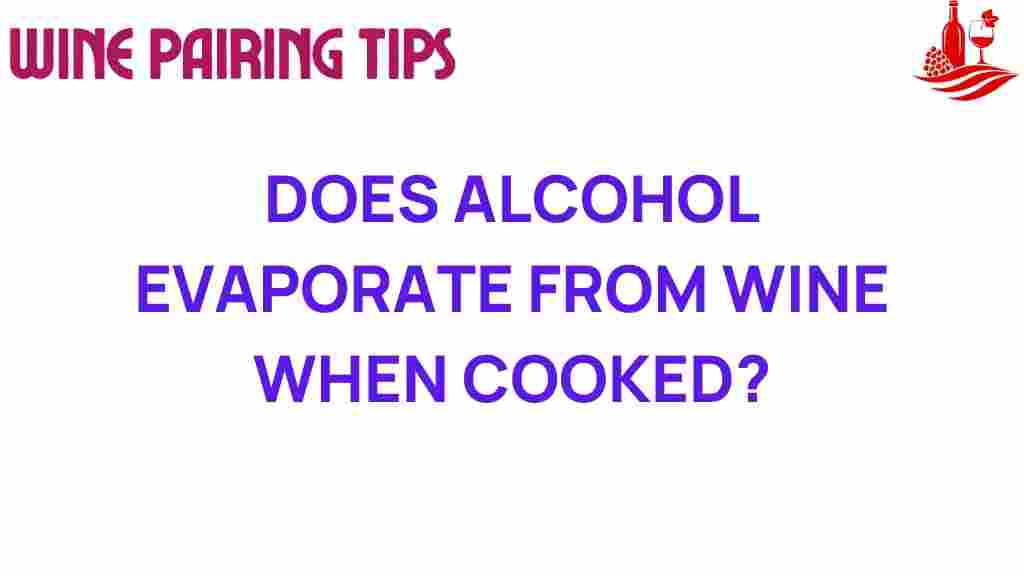Does Alcohol Really Evaporate from Wine When Cooked? The Truth Revealed
Cooking with wine is a common practice in culinary arts, enhancing flavors and creating delectable dishes. However, a prevalent question arises: does alcohol really evaporate from wine when cooked? This article will explore the science behind alcohol evaporation, debunk common wine cooking myths, and provide practical cooking tips for using wine in your recipes.
The Basics of Alcohol Evaporation
Alcohol is a volatile substance, which means it has a relatively low boiling point compared to water. When wine is heated during cooking, the alcohol begins to evaporate. However, the extent of this evaporation depends on various factors, including:
- Cooking time: The longer you cook the wine, the more alcohol will evaporate.
- Cooking temperature: Higher temperatures accelerate the evaporation process.
- Cooking method: Techniques like wine reduction can significantly affect alcohol content.
How Alcohol Content Changes During Cooking
Research indicates that not all alcohol evaporates during cooking. In fact, the initial stages of cooking may retain a significant amount of alcohol. Here’s a general breakdown of how much alcohol remains after various cooking times:
- 15 minutes: About 40% of the alcohol remains.
- 30 minutes: Approximately 35% of the alcohol remains.
- 1 hour: Around 25% of the alcohol remains.
- 2 hours: About 10% of the alcohol remains.
- 3 hours: Roughly 5% of the alcohol remains.
These statistics highlight the importance of cooking duration when considering the alcohol content in your dishes. For those concerned about alcohol consumption, longer cooking times are more effective at reducing alcohol levels.
Common Wine Cooking Myths
Several myths surround the use of wine in cooking. Let’s take a closer look at some of the most common misconceptions:
- Myth 1: All alcohol evaporates when cooking with wine.
- Myth 2: Cooking with wine is only for gourmet dishes.
- Myth 3: You can’t use cheap wine for cooking.
- Myth 4: Alcohol evaporates instantly when heated.
Understanding these myths can help you make informed decisions about cooking with wine and its effects on your dishes.
Culinary Techniques for Cooking with Wine
There are various culinary techniques that utilize wine to enhance flavors in dishes. Here are some popular methods:
- Sauces: Wine is often used as a base for sauces, adding depth and richness.
- Marinades: Including wine in marinades can tenderize meat and infuse flavors.
- Deglazing: After sautéing, adding wine can lift flavorful remnants from the pan.
- Reducing: Simmering wine to concentrate flavors while evaporating alcohol.
Each technique can enhance the overall taste of your meal while also affecting the alcohol content in the final dish.
Flavor Enhancement Through Wine Cooking
The addition of wine not only affects alcohol levels but also significantly enhances the flavor profile of your dishes. Here’s how wine contributes to flavor enhancement:
- Acidity: Wine adds acidity, balancing rich and fatty ingredients.
- Aromatic compounds: The aromatic notes in wine can elevate the overall sensory experience.
- Complexity: Cooking with wine can introduce layers of flavor that enhance the dish.
Choosing the right type of wine is essential for maximizing flavor. Consider the following when selecting wine for cooking:
- White wine: Pairs well with chicken, seafood, and vegetables.
- Red wine: Ideal for beef, lamb, and hearty sauces.
- Fortified wines: Such as sherry or port, can add sweetness and depth to sauces.
Step-by-Step Process for Cooking with Wine
Here’s a simple step-by-step process for incorporating wine into your cooking:
- Choose Your Wine: Select a wine that complements your dish. Opt for a wine you enjoy drinking.
- Determine Cooking Method: Decide whether you’ll be using the wine for deglazing, marinating, or sauce-making.
- Measure the Wine: Use the appropriate amount. Generally, a ½ to 1 cup is sufficient for most recipes.
- Cook It Right: Heat the wine to allow some alcohol to evaporate. For marinades, let it sit for at least 30 minutes.
- Reduce If Necessary: For sauces, simmer the wine to concentrate flavors and reduce alcohol content.
- Pair It Well: Consider food pairing when serving your dish. The right wine can elevate the meal.
Food Pairing Tips When Cooking with Wine
Pairing food with wine can enhance the dining experience. Here are some pairing tips to keep in mind:
- Match Intensity: Pair lighter dishes with white wines and heavier dishes with red wines.
- Complement Flavors: Use wines that echo the flavors in your dish. For example, a citrusy white pairs well with lemon chicken.
- Consider Texture: Rich and creamy dishes benefit from a wine that can cut through the richness.
For more detailed food and wine pairing ideas, you can check out this extensive guide.
Troubleshooting Tips for Cooking with Wine
Sometimes things don’t go as planned in the kitchen. Here are some troubleshooting tips for cooking with wine:
- Too Much Alcohol: If you find your dish still tastes too alcoholic, extend the cooking time to allow for more evaporation.
- Overpowering Flavor: If the wine flavor is too strong, add additional ingredients (like broth or cream) to balance it out.
- Wrong Wine Selection: If you used the wrong wine, consider adjusting the seasonings to better match the flavors.
Conclusion: The Truth About Alcohol Evaporation
In conclusion, while alcohol evaporation does occur when cooking with wine, the extent of evaporation is influenced by cooking time, temperature, and technique. Understanding the science behind wine cooking allows you to maximize flavor while managing alcohol content in your dishes. By debunking wine cooking myths and applying effective culinary techniques, you can enhance your cooking experience and create delicious meals.
So, the next time you reach for that bottle of wine in the kitchen, remember the truth about alcohol evaporation and make your cooking journey more flavorful and enjoyable!
For additional resources and tips on cooking techniques, feel free to visit our cooking tips page.
This article is in the category Tips and created by Wine Pairing Tips Team
